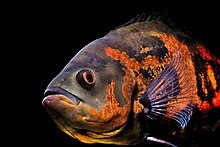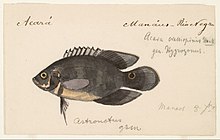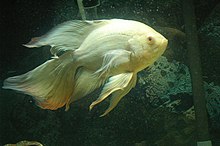Oscar (fish)
| Oscar fish | |
|---|---|

| |
| Scientific classification | |
| Domain: | Eukaryota |
| Kingdom: | Animalia |
| Phylum: | Chordata |
| Class: | Actinopterygii |
| Order: | Cichliformes |
| Family: | Cichlidae |
| Genus: | Astronotus |
| Species: | A. ocellatus
|
| Binomial name | |
| Astronotus ocellatus (Agassiz, 1831)
| |
The oscar (Astronotus ocellatus) is a species of fish from the cichlid family known under a variety of common names, including tiger oscar, velvet cichlid, and marble cichlid.[1] In tropical South America, where the species naturally resides, A. ocellatus specimens are often found for sale as a food fish in the local markets.[2][3] The fish has been introduced to other areas, including India, China, Australia, and the United States. It is considered a popular aquarium fish in Europe and the U.S.[4][5][6]
Taxonomy
The species was originally described by Louis Agassiz in 1831 as Lobotes ocellatus, as he mistakenly believed the species was marine; later work assigned the species to the genus Astronotus.[7] The species also has a number of junior synonyms: Acara compressus, Acara hyposticta, Astronotus ocellatus zebra, and Astronotus orbiculatus.[8]

Description

A. ocellatus examples have been reported to grow to about 45 cm (18 in) in length and 1.6 kilograms (3.5 lb) in weight.
Distribution and habitat

A. ocellatus is native to Brazil, Colombia, Ecuador, Guyana, French Guiana, Suriname, Peru, and Venezuela, and occurs in the
Reproduction
Although the species is widely regarded as sexually monomorphic,[5] males have been suggested to grow more quickly,[citation needed] and in some naturally occurring strains, males are noted to possess dark blotches on the base of their dorsal fins.[6][7] The species reaches sexual maturity around one year of age,[15] and continues to reproduce for 9–10 years.[15] Frequency and timing of spawning may be related to the occurrence of rain.[16] A. ocellatus fish are biparental substrate spawners, though detailed information regarding their reproduction in the wild is scarce.

In captivity, pairs are known to select and clean generally flattened horizontal or vertical surfaces on which to lay their eggs.[citation needed]. Smaller females lay around 300-500 eggs, while larger female oscars can lay about 2,500-3,000 eggs.[15] Like most cichlids, A. ocellatus practices brood care, although the duration of brood care in the wild remains unknown.[6]
In the aquarium

The oscar is one of the most popular cichlids in the aquarium hobby.
Food
Oscar fish are omnivores. Most fish eaten by A. ocellatus in the wild are relatively sedentary catfish, including Bunocephalus, Rineloricaria, and Ochmacanthus species.[9] The species uses a suction mechanism to capture prey,[17] and has been reported to exhibit "lying-on-side" death mimicry in a similar fashion to Parachromis friedrichsthalii and Nimbochromis livingstonii.[18][19] Wild oscars also consume shrimp, snails, insects and insect larvae, as well as fruits and nuts on a seasonal basis.[20] The species also has an absolute requirement for vitamin C, and develops health problems in its absence.[21] Captive oscars generally eat fish food designed for large carnivorous fish: crayfish, worms, and insects (such as flies, crickets and grasshoppers).[22]
Territorial behavior

Oscars will often lay claim to an area of the aquarium and will be very aggressive towards other fish encroaching on their newly established territory inside the aquarium or lake. The size of the territory varies depending on the size and aggressiveness of the fish, and its surroundings. Once the oscar establishes a territory, it will vigorously defend it by chasing away other fish.[23]
Varieties

A number of ornamental varieties of A. ocellatus have been developed for the
References
- ^ a b c Kullander, Sven O. (September 29, 2007). "Astronotus ocellatus, Oscar". FishBase. Archived from the original on 2007-09-29. Retrieved 2007-03-16.
- ^ a b Kullander SO. "Cichlids: Astronotus ocellatus". Swedish Museum of Natural History. Archived from the original on July 27, 2020. Retrieved 2007-03-16.
- ^ Kohler, CC; et al. "Aquaculture Crsp 22nd Annual Technical Report" (PDF). Oregon State University, USA. Archived (PDF) from the original on 2022-10-09. Retrieved 2007-03-16.
- ^ Keith, P. O-Y. Le Bail & P. Planquette, (2000) Atlas des poissons d'eau douce de Guyane (tome 2, fascicule I). Publications scientifiques du Muséum national d'Histoire naturelle, Paris, France. p. 286
- ^ ISBN 978-1-56465-169-3.
- ^ ISBN 978-1-56465-146-4.
- ^ a b c d Robert H. Robins. "Oscar". Florida Museum of Natural History. Archived from the original on 2007-03-05. Retrieved 2007-03-18.
- ^ Froese, R.; D. Pauly. "Synonyms of Astronotus ocellatus". FishBase. Archived from the original on September 29, 2007. Retrieved 2007-03-21.
- ^ JSTOR 1446432. Archived from the original(PDF) on 2012-05-04.
- .
- S2CID 133672039.
- ^ Department of primary industry and fisheries. "Noxious fish – species information". Queensland Government, Australia. Archived from the original on 2007-08-29. Retrieved 2007-03-16.
- ^ United States Geological Survey. "NAS – Species FactSheet Astronotus ocellatus (Agassiz 1831)". United States Government. Archived from the original on 2007-05-02. Retrieved 2007-03-17.
- S2CID 22487662.
- ^ a b c Dowdy, Meredith. "Astronotus ocellatus Marble cichlid (Also: Red oscar; Velvet cichlid)". animaldiversity.org. University of Michigan Museum of Zoology. Retrieved 11 September 2020.
- ^ Pinto Paiva, M & Nepomuceno, FH (1989). "On the reproduction in captivity of the oscar, Astronotus ocellatus (Cuvier), according to the mating methods (Pisces – Cichlidae)". Amazoniana. 10: 361–377.
- S2CID 15051491.)
{{cite journal}}: CS1 maint: multiple names: authors list (link - .
- S2CID 85758542.
- ^ "Feeding Oscars in the Home Aquarium". Tropical Fish Hobbyist. June 2007.
- PMID 9772145.
- ^ "Oscar Fish Diet". Retrieved 31 Jan 2019.
- JSTOR 2387730.
- ISBN 978-3-89356-041-7.
- ^ Mike Giangrasso. "Death by Dyeing – dyed fish list". Death by Dyeing.org. Retrieved 2007-03-18.
